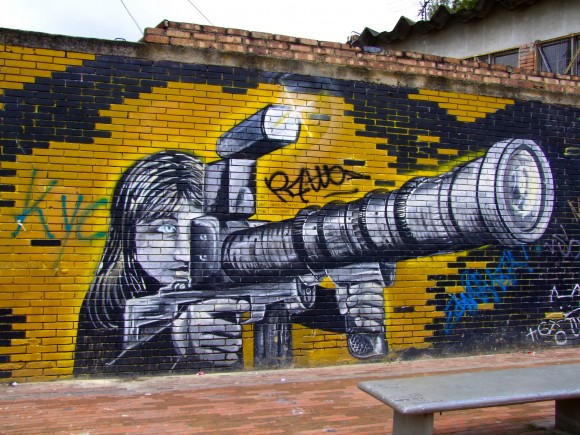 Street art in Colombia depicts violence in every day life. Image credit: Frank Plamann
Street art in Colombia depicts violence in every day life. Image credit: Frank PlamannThe assassination of political actors in Colombia is not a new story, but one that seems to repeat itself in particular territories. Violent acts have spiked in the last few weeks with the assassination of civil society leaders and political actors. The implications of these assassinations are endangering the advances made in the peace process in Havana, and could jeopardise the future of Colombia in a post-agreement phase.
Violence past, violence present
Such violence is reminiscent of practices that have occurred in the country in the past. In previous peace negotiations with FARC, and other armed groups in the country, different actors have taken measures to scare, ostracise and marginalise moderate voices within the country. A sad reminder of this is the massacre of activists from the Union Patriótica (Patriotic Union) party in the late 1980s, and the assassination of three presidential candidates during a single election in the 1990s. Both are illustrative of the danger that activists and civil society actors endure in Colombia.
Understanding who is behind the assassinations and threats currently being made is imperative; this can inform actions to protect moderate voices and weaken the structures terrorising activists in Colombia. Violence is driven by a mixture of actors across the country, including the re-emergent paramilitary forces in Colombia, some local elites, and armed groups that work for the highest bidder.
Politics and paramilitary collide
The paramilitary forces in Colombia are the legacy of a counter insurgency doctrine that led the state to create armed units resembling the Contras in Nicaragua. These paramilitary forces have transcended the framework of being subservient to the state and have acquired a power of their own. In fact, they have made the state subservient to their interests since the late 1980s and acquired regional influence and control in different parts of the country. These forces were involved in a peace process with the state between 2003 and 2006. However their power and influence remains almost intact in several parts of the country under new labels, such as BACRIM, Águilas Negras and others.
Local political elites also play a major role. In some cases, political elites behave like warlords, holding political control and using violence in association with paramilitary groups to defend and assert their economic interests. An example of this is how in several provinces in the country, politicians became involved with paramilitary groups to assert their political dominion.
Finally, there are armed groups that work as violent freelancers for hire. Most of them are criminal bands or gangs that have local and regional influence, but do not express any real political interest in co-opting or assuming roles of the state.
Civil society in the crossfire
It should be highlighted that the role of the state has changed in recent decades from being supportive of some of these paramilitary groups, to being indifferent and, more recently, to combating them. A mixture of incompetence, appreciation, tacit approval and fear has informed the actions of several state officials in the provinces where these organisations exist. We should not forget that paramilitary forces received a standing ovation in the Congress of Colombia during the government of former president (and now senator) Uribe. During this time, paramilitaries controlled 30% of Congress in Colombia and were co-responsible for millions of forced displacements, thousands of deaths and other violations of human rights.
This would seem to reinforce the claim made by several researchers that violence has been used during recent decades to assert particular political and economic interests in Colombia. It might thus be naïve to imagine that all those who have benefited from violence would comply with what is being agreed in Havana. There are different constituencies who are not interested in peace and who, in fact, oppose organisations promoting peace, as well as political overtures for peace in Colombia.
Moving beyond violence
It is important to clarify that while FARC present themselves as the vanguard of civil society initiatives, this is not truly the case. FARC has ascendance over certain constituencies, but the reality is that civil society organisations promoting peace have opposed the violence from FARC in equal measures to that from other paramilitary groups.
We must not forget that FARC are an armed actor - negotiating their inclusion within the democracy of Colombia as a nonviolent actor. The most problematic outcome of the association of civil society groups with FARC is that left wing politicians, activists and civil society organisations who undertake initiatives are often taken to be partisan allies of the FARC, making civil society organisations the object of ostracisation. This underscores the importance of achieving a peace process with FARC in Colombia, as this would create a political opening that would involve broader constituencies beyond the FARC in the Colombian democracy.
However, this political opening is exactly what the armed actions against activists, human rights defenders and left wing politicians are aiming to prevent. Such violence seeks to undermine the agreements with FARC and jeopardises the inception of a wider and broader democracy. The debates occurring in Havana with regard to the security of members of the FARC and associated political groups should transcend Havana and see this threat as what it actually constitutes: a menace to Colombian democracy (not only to FARC) though which warlords, drug-lords and mafias corrupt politicians, and paramilitaries want to coopt and consolidate their grip on parts of the country through the use of violence and terror.
It is necessary to protect political actors and activists from both the left and right, as violence will emerge and be covered by the cloak of political violence. The success of the agreements in Havana depends on the capacity of the state to ensure a political avenue for all the different actors in Colombia.












